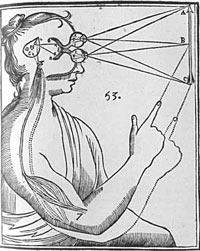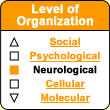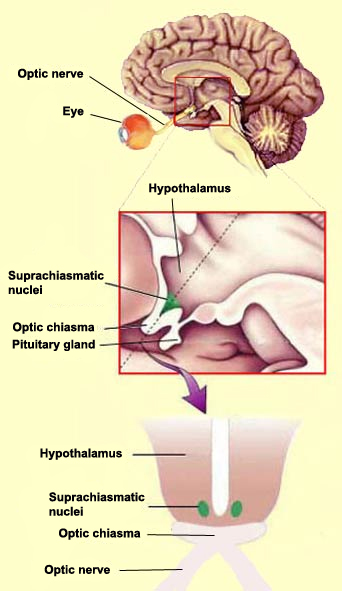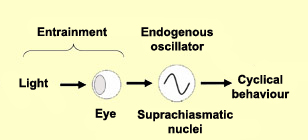Melatonin,
the hormone secreted by the pineal gland, was not discovered
until the late 1950s. Its role in regulating biological rhythms
was then uncovered only gradually, making the pineal gland
the last of the endocrine glands to have its function identified.
For centuries, the role of this gland had been the subject
of much speculation, some of it physiological, but some
of it metaphysical. The pineal gland is the only brain
structure that does not come in a pair, one to the left
and one to the right of the sagittal plane (a virtual surface
separating the two hemispheres), Unlike the other, paired
brain structures, the pineal gland has the appearance of
a single structure (see sidebar to the left) and is located
exactly at the centre of this plane. This distinctive trait
likely helped to feed the speculation about this gland’s
role.
One of the most famous of these theories is certainly that
of the French philosopher René Descartes, who considered
the pineal gland the “seat” of the soul. Descartes
was a dualist and regarded this unique structure as the possible
interface between the material body and the immaterial soul.
 For
example, according to Descartes, for the woman in this illustration
to become aware of the presence of the arrow, the first step
would be a material one, in which the light from the arrow
passed through the air and her eyes and struck her retinas.
The signal would then be retransmitted, again materially,
through a different medium, until it reached the pineal gland.
There the signal would finally become immaterial, entering
the realm of consciousness. This transformation, which even
Descartes could not explain, could also take place in the
opposite direction. For example, if this woman wanted to
aim the arrow, the decision to do so, arising initially in
her immaterial mind, would have to take material form in
the pineal gland, which could then initiate the required
muscle movements. For
example, according to Descartes, for the woman in this illustration
to become aware of the presence of the arrow, the first step
would be a material one, in which the light from the arrow
passed through the air and her eyes and struck her retinas.
The signal would then be retransmitted, again materially,
through a different medium, until it reached the pineal gland.
There the signal would finally become immaterial, entering
the realm of consciousness. This transformation, which even
Descartes could not explain, could also take place in the
opposite direction. For example, if this woman wanted to
aim the arrow, the decision to do so, arising initially in
her immaterial mind, would have to take material form in
the pineal gland, which could then initiate the required
muscle movements.
Pierre Gassendi, a philosopher who was a contemporary of
Descartes, located the mysterious interface between the soul
and the body in a different brain structure, the corpus callosum.
In contrast, modern neurobiologists work from a purely materialist
perspective and reject this Cartesian dualism. |







 For
example, according to Descartes, for the woman in this illustration
to become aware of the presence of the arrow, the first step
would be a material one, in which the light from the arrow
passed through the air and her eyes and struck her retinas.
The signal would then be retransmitted, again materially,
through a different medium, until it reached the pineal gland.
There the signal would finally become immaterial, entering
the realm of consciousness. This transformation, which even
Descartes could not explain, could also take place in the
opposite direction. For example, if this woman wanted to
aim the arrow, the decision to do so, arising initially in
her immaterial mind, would have to take material form in
the pineal gland, which could then initiate the required
muscle movements.
For
example, according to Descartes, for the woman in this illustration
to become aware of the presence of the arrow, the first step
would be a material one, in which the light from the arrow
passed through the air and her eyes and struck her retinas.
The signal would then be retransmitted, again materially,
through a different medium, until it reached the pineal gland.
There the signal would finally become immaterial, entering
the realm of consciousness. This transformation, which even
Descartes could not explain, could also take place in the
opposite direction. For example, if this woman wanted to
aim the arrow, the decision to do so, arising initially in
her immaterial mind, would have to take material form in
the pineal gland, which could then initiate the required
muscle movements.